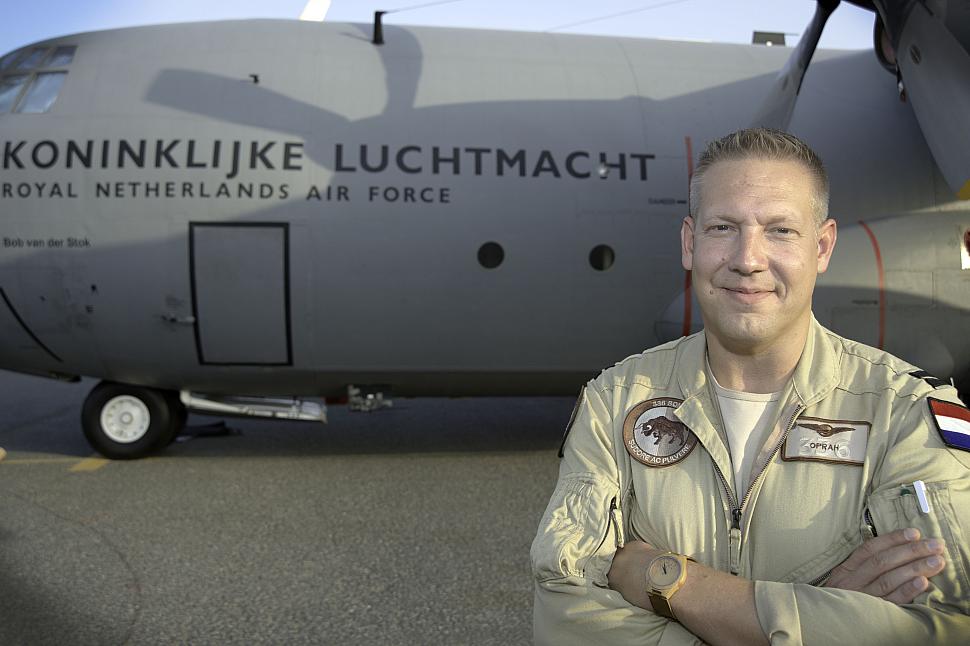C-130 News
C-130 Hercules News
Dutch C-130’s supply coalition fight
October 10, 2017 (by
SSgt. William Banton) -
The Royal Netherlands Air Force completed its first C-130 Hercules supply mission from Southwest Asia in support of coalition forces operating throughout the U.S. Central Command area of responsibility, October 3, 2017.

The mission marked the beginning of a new strategic capability for the RNLAF and is the culmination of months of training and global operational support. Prior to deploying, the RNLAF provided 900,000 pounds of relief freight to the Dutch Caribbean Islands in response to Hurricane Irma.
"They were flying in supplies [from Curacao] to the island of Saint Martin, which was hit pretty hard by the hurricane," said Capt. Gert-jan, 1st (Netherlands) Air Task Force Operation Inherent Resolve C-130 pilot. "They got back and immediately started flying in this direction. The operation tempo is fairly high for our small fleet and the Netherlands think it's really important that we are contributing to the fight against ISIS."
Lt. Col. Cris, 1st (NLD) ATF OIR detachment commander, said he is proud of the ability of the small RNLAF fleet to support missions on multiple continents, and then imbed a new C-130 capability into the theater in such a short period of time.
"That's why it is so important to have the cooperation with the United States for logistical support," Cris said. "It's difficult for us to get logistical flights and supplies here, and the cooperation is working fairly well. The U.S. is supporting us with spare parts and helping us build up our camp, giving us the opportunity to get [our] aircraft into the fight."
Gert-Jan said the high temperatures and low air density of Southwest Asia provide challenges in adapting to working and living in this climate, compared to Europe.
"The runways over here are pretty long, but you can expect [difficulty] when you go into dirt [landing] strips because the heat and the density of the altitude," he said. "When you have an elevation that is higher than sea level, eventually the performance of the aircraft goes down."
Before deploying, the crew trained in the European Air Transport Command's Defense Advanced Airlift Tactics Training Course at the Spanish Air Force Base in Zaragoza. Similar to the U.S. Air Force AATTC, the course teaches tactical awareness academics and includes low level flights, threat reaction and max effort landing training.
The RNLAF has been directly supporting coalition forces in Baghdad with supply missions originating from their home station for more than a year. Gert-Jan said these missions used to entail time-consuming flights to and from the Netherlands and required crews to arrive in the AOR the night prior to the mission.
"Now that we are closer to the AOR, it saves a lot of traveling time, and we can put those flying hours into quickly delivering stuff in and out," Gert-Jan said.
Capt. Gerjan 1 (Netherlands) Air Task Force, OIR pilot, stands in front of the RNLAF C-130 Hercules at an undisclosed location in Southwest Asia, on October 6, 2017. On October 3, the RNLAF completed its first C-130H supply mission which departed from Southwest Asia location. [USAF photo by SSgt. William Banton]
"They were flying in supplies [from Curacao] to the island of Saint Martin, which was hit pretty hard by the hurricane," said Capt. Gert-jan, 1st (Netherlands) Air Task Force Operation Inherent Resolve C-130 pilot. "They got back and immediately started flying in this direction. The operation tempo is fairly high for our small fleet and the Netherlands think it's really important that we are contributing to the fight against ISIS."
Lt. Col. Cris, 1st (NLD) ATF OIR detachment commander, said he is proud of the ability of the small RNLAF fleet to support missions on multiple continents, and then imbed a new C-130 capability into the theater in such a short period of time.
"That's why it is so important to have the cooperation with the United States for logistical support," Cris said. "It's difficult for us to get logistical flights and supplies here, and the cooperation is working fairly well. The U.S. is supporting us with spare parts and helping us build up our camp, giving us the opportunity to get [our] aircraft into the fight."
Gert-Jan said the high temperatures and low air density of Southwest Asia provide challenges in adapting to working and living in this climate, compared to Europe.
"The runways over here are pretty long, but you can expect [difficulty] when you go into dirt [landing] strips because the heat and the density of the altitude," he said. "When you have an elevation that is higher than sea level, eventually the performance of the aircraft goes down."
Before deploying, the crew trained in the European Air Transport Command's Defense Advanced Airlift Tactics Training Course at the Spanish Air Force Base in Zaragoza. Similar to the U.S. Air Force AATTC, the course teaches tactical awareness academics and includes low level flights, threat reaction and max effort landing training.
The RNLAF has been directly supporting coalition forces in Baghdad with supply missions originating from their home station for more than a year. Gert-Jan said these missions used to entail time-consuming flights to and from the Netherlands and required crews to arrive in the AOR the night prior to the mission.
"Now that we are closer to the AOR, it saves a lot of traveling time, and we can put those flying hours into quickly delivering stuff in and out," Gert-Jan said.
Courtesy of 386th Air Expeditionary Wing Public Affairs
Related articles:
Forum discussion:
Tags
Forum discussion:
- Start a discussion about this article in the C-130.net forum.
Tags
